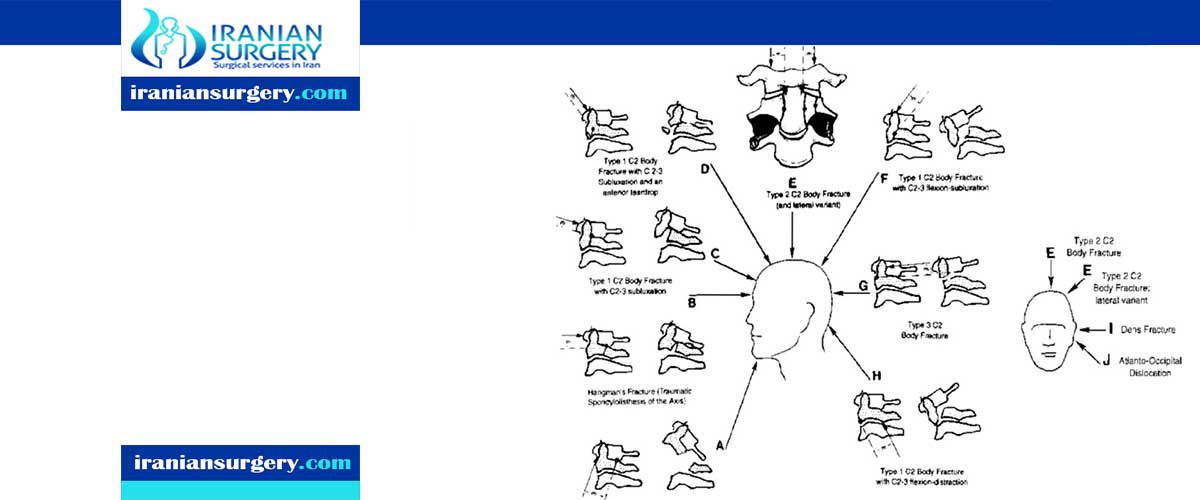Cervical Fracture Types

Cervical Fracture Spine Types
Cervical fractures and dislocations are typically classified according to their region/location and injury/fracture pattern. Because of the unique anatomy of the spine in the region close to the head, cervical injuries are categorized as occipital-cervical (occiput-C2) and subaxial cervical spine (C3-C7) injuries. Within each of these categories, injuries are further stratified according to the specific location of injury and injury/fracture pattern.
Occipital-Cervical Spine (Occiput-C2)
- Atlanto-Occipital Dislocation (AOD)
- Occipital Condyle Fracture
- Atlanto-Axial Instability
- Atantoaxial Rotatory Subluxation
- Atlas Fractures (C1)
- Odontoid Fractures (C2 dens)
- Traumatic Spondylolisthesis of the Axis (C2)
- Axis Fractures (C2 vertebral body)
Subaxial Cervical Spine (C3-C7)
- Distraction-Flexion (Facet fracture/dislocation)
- Vertical Compression (Burst fracture)
- Compression-Flexion (Teardrop fracture)
- Compression-Extension
- Distraction-Extension
- Lateral Flexion
The most common fracture mechanism in cervical injuries is hyperflexion.
- Anterior subluxation occurs when the posterior ligaments rupture.
Since the anterior and middle columns remain intact, this fracture is stable. - Simple wedge fracture is the result of a pure flexion injury. The posterior ligaments remain intact. Anterior wedging of 3mm or more suggests fracture. Increased concavity along with increased density due to bony impaction. Usualy involves the upper endplate.
- Unstable wedge fracture is an unstable flexion injury due to damage to both the anterior column (anterior wedge fracture) as the posterior column (interspinous ligament).
- Unilateral interfacet dislocation is due to both flexion and rotation.
- Bilateral interfacet dislocation is the result of extreme flection. BID is unstable and is associated with a high incidence of cord damage.
- Flexion teardrop farcture is the result of extreme flection with axial loading. It is unstable and is associated with a high incidence of cord damage.
- Anterior atlantoaxial dislocation
10 common questions about Cervical Fracture Types
1What is a cervical fracture?
A cervical fracture, commonly called a broken neck, is a catastrophic fracture of any of the seven cervical vertebrae in the neck. ... Abnormal movement of neck bones or pieces of bone can cause a spinal cord injury resulting in loss of sensation, paralysis, or usually instant death
2How long does it take to recover from a broken neck?
How long does it take to recover? A simple break that doesn't affect your spinal cord can be treated with a neck brace worn for six to eight weeks until the bone heals. More complicated breaks can require surgery and other treatments such as a stiff neck brace for up to three months
3Can you fracture your neck without knowing?
A neck fracture is a break in one or more of the cervical bones (vertebrae in the neck). A person with a neck injury should not be moved without competent medical care, which should be summoned immediately. It is important to recognize the possibility of a neck fracture
4How is a cervical fracture treated?
A minor compression fracture can be treated with a cervical brace worn for 6 to 8 weeks until the bone heals. A more complex or extensive fracture may require traction, surgery, 2 to 3 months in a rigid cast, or a combination of these treatments
5How serious is a neck fracture?
Fractured Neck Symptoms
A neck fracture is very serious and can lead to paralysis or possibly death. A person with a neck injury should not be moved without competent medical care, which is needed immediately. Neck fracture may cause: Severe pain.
6How serious is a c2 fracture?
The hangman's fracture refers to a break in a bone known as C2, because it is the second bone down from the skull in your cervical (neck) vertebrae. A fracture can be a partial or complete break in a bone. The injury can also cause the C2 to move out of alignment with the bone right below it, known as the C3.
7How serious is a fractured vertebrae?
Severe pain at the site of the fracture is the main symptom of a broken back injury. If back pain is made worse when you move, that's also a sign that a vertebra may have been broken. If, however, the broken bone compresses the spinal cord's other nerves, there may be numbness as well as pain
8What does c7 control?
C7 spinal nerve.
This nerve has a sensory root and a motor root. The C7 dermatome is an area of skin that receives sensations through the C7 nerve. This dermatome includes areas of skin covering the shoulders, back of the arms, and the middle finger. The C7 myotome is a group of muscles controlled by the C7 nerve.
9What is a c5 fracture?
C5 Vertebrae. Damage to the spinal cord at the C5 vertebra affects the vocal cords, biceps, and deltoid muscles in the upper arms. Unlike some of the higher cervical injuries, a patient with a C5 spinal cord injury will likely be able to breath and speak on their own.
10Can I snap my own neck?
It isn't possible to (with the strength of your arms) snap your own neck. Just the same way as it's not possible to pick yourself up off the ground, using only your hands. ... Another reason you can't break your own neck with your hands, is because we instinctively avoid pain, and damage
[kkstarratings]


